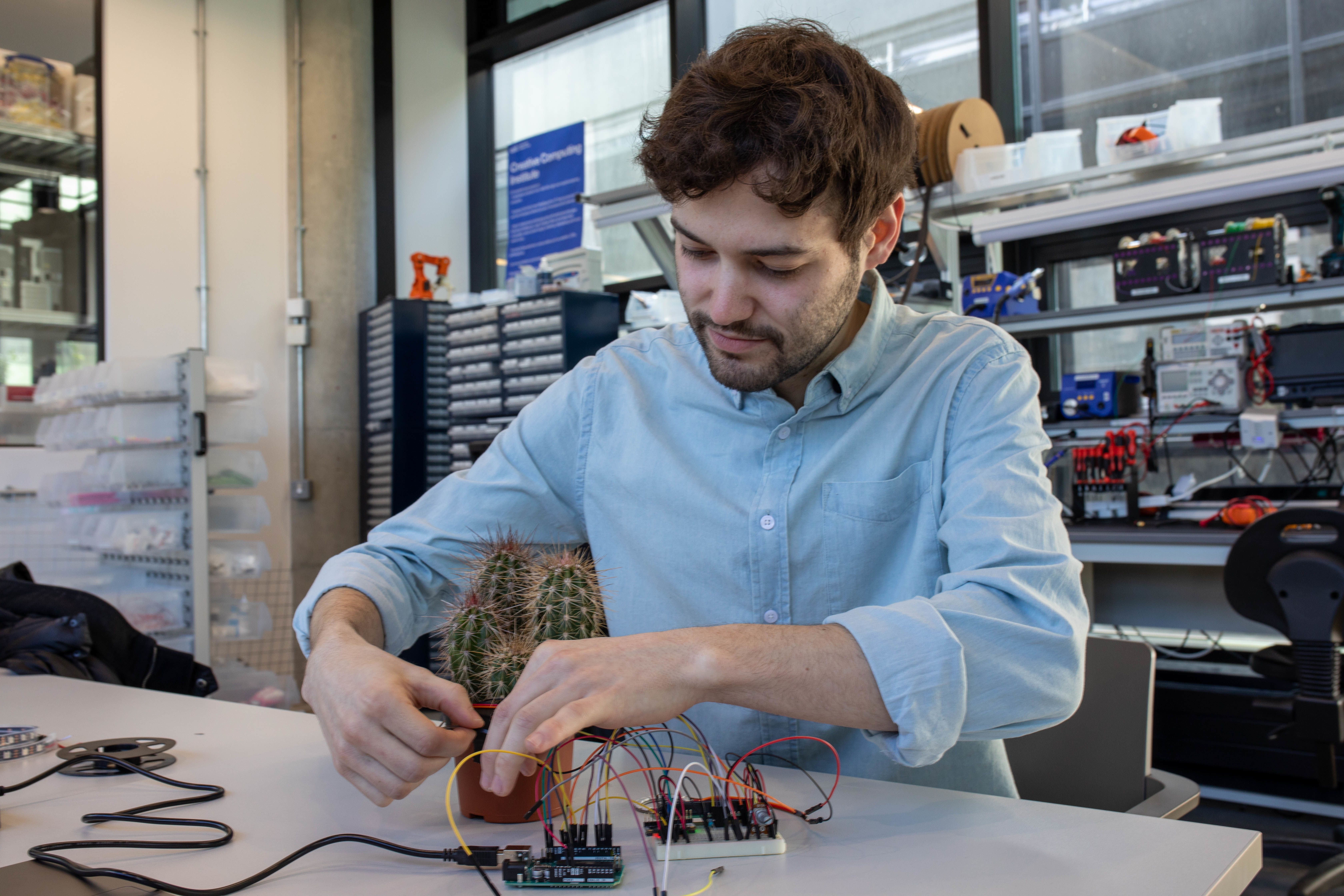
From disobedient robots to cacti that play Madonna: Meet CCI student Adam Cole

- Written byAnnika Loebig
- Published date 26 April 2022

If you visit the Creative Computing Institute (CCI), you might spot Adam Cole leaning in to kiss a robot only for it to reject him and retreat back into its box.
“It wasn’t always supposed to reject you,” Adam says. “But the first time I tested it with lips, it was so uncanny and unsettling, not so much because it was mechanical, but because how weird it was to imagine that this could be a possible future.”
Adam is a postgraduate student at CCI, exploring the ways in which interactive installations using both hardware and software can engage users in posing questions about intimacy, authenticity and relationships.
Adam’s project REJECTED BY MY OWN ROBOT is meant to challenge our assumption that technology is always going to be efficient and work without error.
“Because [technology] is a source of pleasure in all ways we see it in our world, I think there is a lot of power in making devices that actively subvert those expectations that are so built into the way technology works in our capitalist society. So, I would encourage more people to design disobedient robots and see what our world looked like if technology wasn’t always a domain for control and pleasure-seeking.”

Adam first got into creative computing after his dad gifted him a computer. Shortly after, he explored his interest in digital creative practice further by getting involved with film editing. Before landing at UAL, he studied Cognitive Science and Artificial Intelligence, and shortly after transferred to a Digital Media Design programme at university, which merged computer science with fine arts. Despite meeting people with an arts and design background when working for Slack for 4 years after graduating, he missed being part of a creative community and decided to apply to UAL.
“In terms of creative computing, I never would’ve used that title for myself until this programme stamps it on you. It’s a really broad term, and so it gives a lot of flexibility to whatever you want to delve into.”
For Adam, joining CCI allowed him to extend his film influences into the creative computing space by creating algorithmically generated graphics that pair with audio visual experiences to evoke a cinematic feeling.
“What I really love about creative coding is that you don’t go in with an expectation or idea of what your final piece is going to look like. It’s sort of about exploring the space of what is possible - setting up an algorithm that can create a bunch of shapes, most of which are going to be completely uninteresting, and finding the right parameters, the right numbers, to somehow suddenly have this grace and beauty.”

For a recent assignment, he was asked to build a prototype for what could be scaled up into a larger installation, involving the word ‘touch’. Instantly, he started subverting the expectations of what materials could be touchable or untouchable – and landed on a cactus.
The prototype consists of a small cactus whose flesh he turned into a touch sensor by connecting wires to a vibrating motor and plugging them into the plant, playing ‘Like a Virgin’ by Madonna when touched. The scaled-up version of this project would take the shape of a human body and serve as a metaphor about intimacy, the defences we put up between each other and the way in which people have to risk hurt to feel touch, Adam explains.
When he first joined the CCI, the involvement of hardware helped him expand his prior interest in audio-visual coding, specifically around the concept of video music, while considering the climate footprint of working with hardware technologies. In future projects, he’d like to continue building robots whose focal points centre around intimacy, specifically communication, and encourage users to participate in cinematic, immersive experiences.
“What I really enjoyed about my physical computing is their sense of humour, a sense of joy, just the delight people have when they feel like their environments are reactive.”
“I just started a project that’s using algorithmically generated images on a projector that’s hooked up to a raspberry pie that reacts to your distance from the projection screen. So, the closer you get to it, the closer the animation feels to you. It’s an immersive experience, the graphics are connected to music but they’re also in relationship with you since they change as you approach and recede. So, that’s a world I’d really like to explore further.”